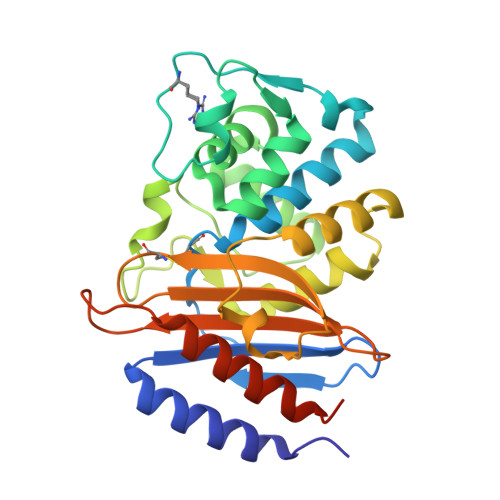The basis for carbapenem hydrolysis by class A beta-lactamases: a combined investigation using crystallography and simulations.
Fonseca, F., Chudyk, E.I., van der Kamp, M.W., Correia, A., Mulholland, A.J., Spencer, J.(2012) J Am Chem Soc 134: 18275-18285
- PubMed: 23030300
- DOI: https://doi.org/10.1021/ja304460j
- Primary Citation of Related Structures:
4EQI, 4EUZ, 4EV4 - PubMed Abstract:
Carbapenems are the most potent β-lactam antibiotics and key drugs for treating infections by Gram-negative bacteria. In such organisms, β-lactam resistance arises principally from β-lactamase production. Although carbapenems escape the activity of most β-lactamases, due in the class A enzymes to slow deacylation of the covalent acylenzyme intermediate, carbapenem-hydrolyzing class A β-lactamases are now disseminating in clinically relevant bacteria. The reasons why carbapenems are substrates for these enzymes, but inhibit other class A β-lactamases, remain to be fully established. Here, we present crystal structures of the class A carbapenemase SFC-1 from Serratia fonticola and of complexes of its Ser70 Ala (Michaelis) and Glu166 Ala (acylenzyme) mutants with the carbapenem meropenem. These are the first crystal structures of carbapenem complexes of a class A carbapenemase. Our data reveal that, in the SFC-1 acylenzyme complex, the meropenem 6α-1R-hydroxyethyl group interacts with Asn132, but not with the deacylating water molecule. Molecular dynamics simulations indicate that this mode of binding occurs in both the Michaelis and acylenzyme complexes of wild-type SFC-1. In carbapenem-inhibited class A β-lactamases, it is proposed that the deacylating water molecule is deactivated by interaction with the carbapenem 6α-1R-hydroxyethyl substituent. Structural comparisons with such enzymes suggest that in SFC-1 subtle repositioning of key residues (Ser70, Ser130, Asn132 and Asn170) enlarges the active site, permitting rotation of the carbapenem 6α-1R-hydroxyethyl group and abolishing this contact. Our data show that SFC-1, and by implication other such carbapenem-hydrolyzing enzymes, uses Asn132 to orient bound carbapenems for efficient deacylation and prevent their interaction with the deacylating water molecule.
Organizational Affiliation:
School of Cellular and Molecular Medicine, University of Bristol, Medical Sciences Building, University Walk, Bristol BS8 1TD, United Kingdom. [email protected]


















